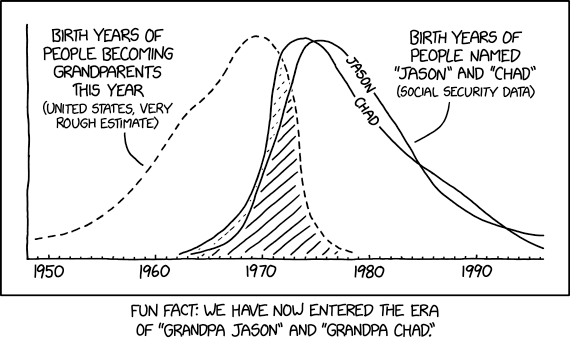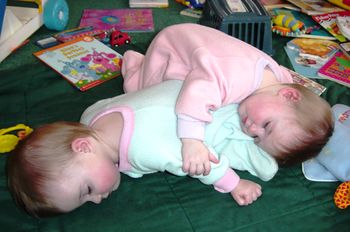Community Data Science Workshops (Core)/Workshop/Baby Names: Difference between revisions
(→Setup) |
No edit summary |
||
| (23 intermediate revisions by 7 users not shown) | |||
| Line 1: | Line 1: | ||
{{Template:CDSW Header}} | |||
== Baby Names == | == Baby Names == | ||
[[File:Being a twin means you always have a pillow or blanket handy.jpg|350px]] | [[File:Being a twin means you always have a pillow or blanket handy.jpg|350px]] | ||
How many babies were born last year with your name? Are a wider variety of names used for boys or for girls? What are the most popular names used for both boys and girls? This session will use data from the US Social Security Administration on baby names from the last several years to answer these questions and more! | |||
== | == Goals == | ||
* Have fun exploring real data on baby names in the US | |||
* Practice manipulating and searching strings | |||
* Practice using dictionaries | |||
* Practice using numbers and doing simple arithmatic | |||
== | == Setup == | ||
You | You only need to follow the instructions within the section marked "Baby Names" on [[Community Data Science Workshops (Core)/Workshop/Baby Names/Setup|this page]]. | ||
== | <!-- == Handout == | ||
* [[Baby Names handout]] - something like the [[Wordplay handout]] would be nice! | |||
--> | |||
== Details == | |||
There are a number of files in the <code>babynames.zip</code> archive file. We will work in the jupyter notebook <code>BabyNames.ipynb</code>. | |||
The notebook begins with this line: | |||
import ssadata | |||
This imports the ssdata module which is a special Python module we created for this project that includes only two things: | |||
* <code>ssadata.boys</code> - A dictionary where the the keys are names of boys and the values are the number of infants born in 2018 who had that particular name. | |||
* <code>ssadata.girls</code> - A dictionary where the the keys are names of boys and the values are the number of infants born in 2018 who had that particular name. | |||
If you are in the directory that contains the babynames projects files, you can run the following code in the interactive Python interpreter to print out the dictionary of girls: | |||
import ssadata | |||
ssadata.girls | |||
We'll walk through the rest of the important details in the session! | |||
== Ideas for exercises == | == Ideas for exercises == | ||
# Search for your own name. Are there both boys and girls that have your name? Is it more popular for one group than for the other? | # Search for your own name. Are there both boys and girls that have your name? Is it more popular for one group than for the other? | ||
# Are there more boys names or girls names? What about for particular letters? What about for ''every'' letter? | # Are there more boys' names or girls' names? What about for particular first letters? What about for ''every'' first letter? | ||
# How many boys and girls are described in the dataset (i.e., how many boys and girls born in 2020 have names given to at least four others)? | |||
# What is the longest name in the dataset? | # What is the longest name in the dataset? | ||
# How many boys | # How many boys' names are also girls' names? How many girls' names are also boys' names? | ||
# How many names are subsets of other names? | # How many names are subsets of other names? | ||
# Write a program that will take a name as input and return the number of girls and boys with that name. | # Write a program that will take a name as input and return the number of girls and boys with that name. | ||
# What is the most popular girls name that is also a boys name? | # What is the most popular girls' name that is also a boys' name? | ||
# Take a prefix as input and print the number of boys and girls with that prefix | # Take a prefix as input and print the number of boys and girls with that prefix (i.e., "m" would list babies whose names start with "m" and "ma" would list babies whose names start with "ma", etc). | ||
https://imgs.xkcd.com/comics/grandpa_jason_and_grandpa_chad.png | |||
[[Category:CDSW]] | |||
Latest revision as of 20:45, 22 February 2020
Baby Names[edit]
How many babies were born last year with your name? Are a wider variety of names used for boys or for girls? What are the most popular names used for both boys and girls? This session will use data from the US Social Security Administration on baby names from the last several years to answer these questions and more!
Goals[edit]
- Have fun exploring real data on baby names in the US
- Practice manipulating and searching strings
- Practice using dictionaries
- Practice using numbers and doing simple arithmatic
Setup[edit]
You only need to follow the instructions within the section marked "Baby Names" on this page.
Details[edit]
There are a number of files in the babynames.zip archive file. We will work in the jupyter notebook BabyNames.ipynb.
The notebook begins with this line:
import ssadata
This imports the ssdata module which is a special Python module we created for this project that includes only two things:
ssadata.boys- A dictionary where the the keys are names of boys and the values are the number of infants born in 2018 who had that particular name.ssadata.girls- A dictionary where the the keys are names of boys and the values are the number of infants born in 2018 who had that particular name.
If you are in the directory that contains the babynames projects files, you can run the following code in the interactive Python interpreter to print out the dictionary of girls:
import ssadata ssadata.girls
We'll walk through the rest of the important details in the session!
Ideas for exercises[edit]
- Search for your own name. Are there both boys and girls that have your name? Is it more popular for one group than for the other?
- Are there more boys' names or girls' names? What about for particular first letters? What about for every first letter?
- How many boys and girls are described in the dataset (i.e., how many boys and girls born in 2020 have names given to at least four others)?
- What is the longest name in the dataset?
- How many boys' names are also girls' names? How many girls' names are also boys' names?
- How many names are subsets of other names?
- Write a program that will take a name as input and return the number of girls and boys with that name.
- What is the most popular girls' name that is also a boys' name?
- Take a prefix as input and print the number of boys and girls with that prefix (i.e., "m" would list babies whose names start with "m" and "ma" would list babies whose names start with "ma", etc).


